Provläsningsexemplar / Preview
INTERNATIONAL
STANDARD
ISO
14229-3
First edition
2012-12-01
Corrected version
2013-01-15
Part 3:
Road vehicles — Unified diagnostic
services (UDS) —
Unified diagnostic services on CAN
implementation (UDSonCAN)
Véhicules routiers — Services de diagnostic unifiés (SDU) —
Partie 3: SDU sur l’implémentation du gestionnaire de réseau de
communication (SDUsurCAN)
Reference number
ISO 14229-3:2012(E)
© ISO 2012
�
ISO 14229-3:2012(E)
Provläsningsexemplar / Preview
COPYRIGHT PROTECTED DOCUMENT
© ISO 2012
All rights reserved. Unless otherwise specified, no part of this publication may be reproduced or utilized in any form or by any
means, electronic or mechanical, including photocopying and microfilm, without permission in writing from either ISO at the
address below or ISO’s member body in the country of the requester.
ISO copyright office
Case postale 56 • CH-1211 Geneva 20
Tel. + 41 22 749 01 11
Fax + 41 22 749 09 47
E-mail copyright@iso.org
Web www.iso.org
Published in Switzerland
ii
© ISO 2012 – All rights reserved
�
Provläsningsexemplar / Preview
ISO 14229-3:2012(E)
1
2
3
4
5
6
7
Contents
Page
Foreword ........................................................................................................................................................................................................................................iv
Introduction ..................................................................................................................................................................................................................................v
Scope .................................................................................................................................................................................................................................1
Normative references ......................................................................................................................................................................................1
Terms, definitions and abbreviated terms ................................................................................................................................1
Terms and definitions .......................................................................................................................................................................1
3.1
3.2
Abbreviated terms ...............................................................................................................................................................................1
Conventions ...............................................................................................................................................................................................................2
Document overview...........................................................................................................................................................................................2
Unified diagnostic services implementation on CAN .....................................................................................................4
6.1
General ...........................................................................................................................................................................................................4
6.2
UDS on CAN services overview .................................................................................................................................................4
6.3
ResponseOnEvent (0x86) service DoCAN implementation requirements .........................................5
ReadDataByPeriodicIdentifier (0x2A) service ............................................................................................................7
6.4
Application layer requirements ........................................................................................................................................................13
Application layer services ..........................................................................................................................................................13
7.1
Application layer protocol ..........................................................................................................................................................13
7.2
7.3
Application layer timing...............................................................................................................................................................13
Presentation layer requirements .....................................................................................................................................................13
Session layer requirements ....................................................................................................................................................................13
Transport/Network layer interface adaptation ................................................................................................................13
10.1 General information ........................................................................................................................................................................13
10.2 DoCAN Transport/Network layer interface adaptation ...................................................................................14
Data link layer diagnostic implementation requirements ....................................................................................15
11.1 Usage of legislated 11-bit OBD CAN Identifiers for enhanced diagnostics ......................................15
11.2 Usage of legislated 29-bit OBD CAN Identifiers for enhanced diagnostics ......................................15
Bibliography .............................................................................................................................................................................................................................16
8
9
10
11
© ISO 2012 – All rights reserved
iii
�
ISO 14229-3:2012(E)
Provläsningsexemplar / Preview
Foreword
ISO (the International Organization for Standardization) is a worldwide federation of national standards
bodies (ISO member bodies). The work of preparing International Standards is normally carried out
through ISO technical committees. Each member body interested in a subject for which a technical
committee has been established has the right to be represented on that committee. International
organizations, governmental and non-governmental, in liaison with ISO, also take part in the work.
ISO collaborates closely with the International Electrotechnical Commission (IEC) on all matters of
electrotechnical standardization.
International Standards are drafted in accordance with the rules given in the ISO/IEC Directives, Part 2.
The main task of technical committees is to prepare International Standards. Draft International
Standards adopted by the technical committees are circulated to the member bodies for voting.
Publication as an International Standard requires approval by at least 75 % of the member bodies
casting a vote.
Attention is drawn to the possibility that some of the elements of this document may be the subject of
patent rights. ISO shall not be held responsible for identifying any or all such patent rights.
ISO 14229-3 was prepared by Technical Committee ISO/TC 22, Road vehicles, Subcommittee SC 3,
Electrical and electronic equipment.
This first edition of ISO 14229-3 cancels and replaces ISO 15765-3:2004.
This corrected version incorporates the above information regarding ISO 14229-3 cancelling and
replacing ISO 15765-3:2004.
ISO 14229 consists of the following parts, under the general title Road vehicles — Unified diagnostic
services (UDS):
— Part 1: Specification and requirements
— Part 2: Session layer services
— Part 3: Unified diagnostic services on CAN implementation (UDSonCAN)
— Part 4: Unified diagnostic services on FlexRay implementation (UDSonFR)
— Part 5: Unified diagnostic services on Internet Protocol implementation (UDSonIP)
— Part 6: Unified diagnostic services on K-Line implementation (UDSonK-Line)
The following parts are under preparation / are planned:
— Part 7: Unified diagnostic services on Local Interconnet Network implementation(UDSonLIN)
iv
© ISO 2012 – All rights reserved
�
Provläsningsexemplar / Preview
ISO 14229-3:2012(E)
Introduction
This part of ISO 14229 has been established in order to enable the implementation of unified diagnostic
services, as specified in ISO 14229-3, on Controller Area Networks (UDSonCAN).
To achieve this, it is based on the Open Systems Interconnection (OSI) Basic Reference Model specified in
ISO/IEC 7498-1 and ISO/IEC 10731, which structures communication systems into seven layers. When
mapped on this model, the services specified by ISO 14229 are divided into
— Application layer (layer 7):
— Vehicle manufacturer enhanced diagnostics: ISO 14229-1, ISO 14229-3,
— Legislated OBD: ISO 15031-5,
— Legislated WWH-OBD: ISO 14229-1 / ISO 27145-3;
— Presentation layer (layer 6):
— Vehicle manufacturer enhanced diagnostics: vehicle manufacturer specific,
— Legislated OBD: SAE J1930-DA, SAE J1979-DA, SAE J2012-DA,
— Legislated WWH-OBD: ISO 27145-2 with reference to SAE J1930-DA, SAE J1939, Companion
Spreadsheet (SPNs), SAE J1939-73:2010, Appendix A (FMIs), SAE J1979-DA and SAE J2012-DA;
— Session layer services (layer 5):
— Vehicle manufacturer enhanced diagnostics: ISO 14229-2,
— Legislated OBD: ISO 14229-2,
— Legislated WWH-OBD: ISO 14229-2;
— Transport layer services (layer 4):
— Vehicle manufacturer enhanced diagnostics: ISO 15765-2,
— Legislated OBD: ISO 15765-2, ISO 15765-4
— Legislated WWH-OBD: ISO 27145-4;
— Network layer services (layer 3):
— Vehicle manufacturer enhanced diagnostics: ISO 15765-2,
— Legislated OBD: ISO 15765-2, ISO 15765-4
— Legislated WWH-OBD: ISO 27145-4;
— Data link layer (layer 2):
— Vehicle manufacturer enhanced diagnostics: ISO 11898-1, ISO 11898-2, ISO 11898-3, ISO 11898-5,
— Legislated OBD: ISO 11898-1, ISO 11898-2, ISO 15765-4,
— Legislated WWH-OBD: ISO 27145-4;
— Physical layer (layer 3):
— Vehicle manufacturer enhanced diagnostics: ISO 11898-1, ISO 11898-2, ISO 11898-3, ISO 11898-5,
— Legislated OBD: ISO 11898-1, ISO 11898-2, ISO 15765-4,
v
© ISO 2012 – All rights reserved
�
Table 1 — DoCAN enhanced diagnostics, legislated OBD and WWH-OBD specification reference
applicable to the OSI layers
ISO 14229-3:2012(E)
— Legislated WWH-OBD: ISO 27145-4;
in accordance with Table 1.
Applicability
Seven layer
according to
ISO/IEC 7498-1
and ISO/
IEC 10731
OSI 7 layers
Application
(layer 7)
Presentation
(layer 6)
Session
(layer 5)
Transport
(layer 4)
Network
(layer 3)
Data link
(layer 2)
Physical
(layer 1)
Vehicle manufac-
turer enhanced
diagnostics
ISO 14229-1, ISO/
FDIS 14229-3
vehicle manufac-
turer specific
ISO 15765-2
ISO 11898-1,
ISO 11898-2,
ISO 11898-3,
ISO 11898-5
Provläsningsexemplar / Preview
Legislated
OBD
(On-Board
Diagnostics)
ISO 15031-5
SAE J1930-DA,
SAE J1979-DA,
SAE J2012-DA
ISO 15765-2,
ISO 15765-4
ISO 11898-1,
ISO 11898-2,
ISO 15765-4
Legislated WWH-OBD
(On-Board Diagnostics)
ISO 14229-1, ISO 27145-3
ISO 27145-2 SAE J1930-DA,
SAE J1939 Companion Spreadsheet (SPNs),
SAE J1939 −73:2010, Appendix A (FMIs),
SAE J1979-DA, SAE J2012-DA
ISO 14229-2
ISO 15765-2,
ISO 13400-2
ISO 15765-4
ISO 11898-1,
ISO 13400-3,
ISO 11898-2,
IEEE 802.3
ISO 15765-4
ISO 27145-4
vi
© ISO 2012 – All rights reserved
�
INTERNATIONAL STANDARD
ISO 14229-3:2012(E)
Provläsningsexemplar / Preview
1 Scope
Road vehicles — Unified diagnostic services (UDS) —
Unified diagnostic services on CAN implementation
(UDSonCAN)
Part 3:
This part of ISO 14229 specifies the implementation of a common set of unified diagnostic services
(UDS) on controller area networks (CAN) in road vehicles (UDSonCAN).
UDSonCAN references ISO 14229-1 and ISO 14229-2 and specifies implementation requirements of the
diagnostic services to be used for diagnostic communication over CAN.
UDSonCAN does not specify any requirement for the in-vehicle CAN bus architecture.
NOTE
This part of ISO 14229 does not include any redundant information of the documents as listed in the
Introduction. It focuses on
— additional requirements specific to the implementation of UDS on the CAN network, and
— specific restrictions in the implementation of UDS on the CAN network.
The following documents, in whole or in part, are normatively referenced in this document and are
indispensable for its application. For dated references, only the edition cited applies. For undated
references, the latest edition of the referenced document (including any amendments) applies.
ISO 14229-1, Road vehicles — Unified diagnostic services (UDS) — Part 1: Specification and requirements
ISO 14229-2, Road vehicles — Unified diagnostic services (UDS) — Part 2: Session layer services
ISO 15765-1, Road vehicles — Diagnostic communication over Controller Area Network (DoCAN) — Part 1:
ISO 15765-2, Road vehicles — Diagnostic communication over Controller Area Network (DoCAN) — Part 2:
ISO 15765-4, Road vehicles — Diagnostic communication over Controller Area Network (DoCAN) — Part 4:
2 Normative references
General information and use case definition
Transport protocol and network layer services
Requirements for emissions-related systems
3 Terms, definitions and abbreviated terms
3.1 Terms and definitions
For the purposes of this document, the terms and definitions given in ISO 14229-1, ISO 14229-2,
ISO 15765-1, ISO 15765-2 and ISO 15765-4 apply.
© ISO 2012 – All rights reserved
1
�
ISO 14229-3:2012(E)
Provläsningsexemplar / Preview
3.2 Abbreviated terms
CF
consecutive frame
DA
destination address
DLC
data length code
FF
first frame
FC
flow control
ID
identifier
NA
network address
SA
source address
SF
single frame
SM
subnet mask
SOM
start of message
STRT
serviceToRespondTo
TA
target address
UDS
unified diagnostic services
USDT
unacknowledged segmented data transfer
UUDT
unacknowledged unsegmented data transfer
This part of ISO 14229 is based on the conventions discussed in the OSI Service Conventions
(ISO/IEC 10731:1994) as they apply for diagnostic services.
Figure 1 illustrates the documents required to implement UDSonCAN.
5 Document overview
4 Conventions
2
© ISO 2012 – All rights reserved
�
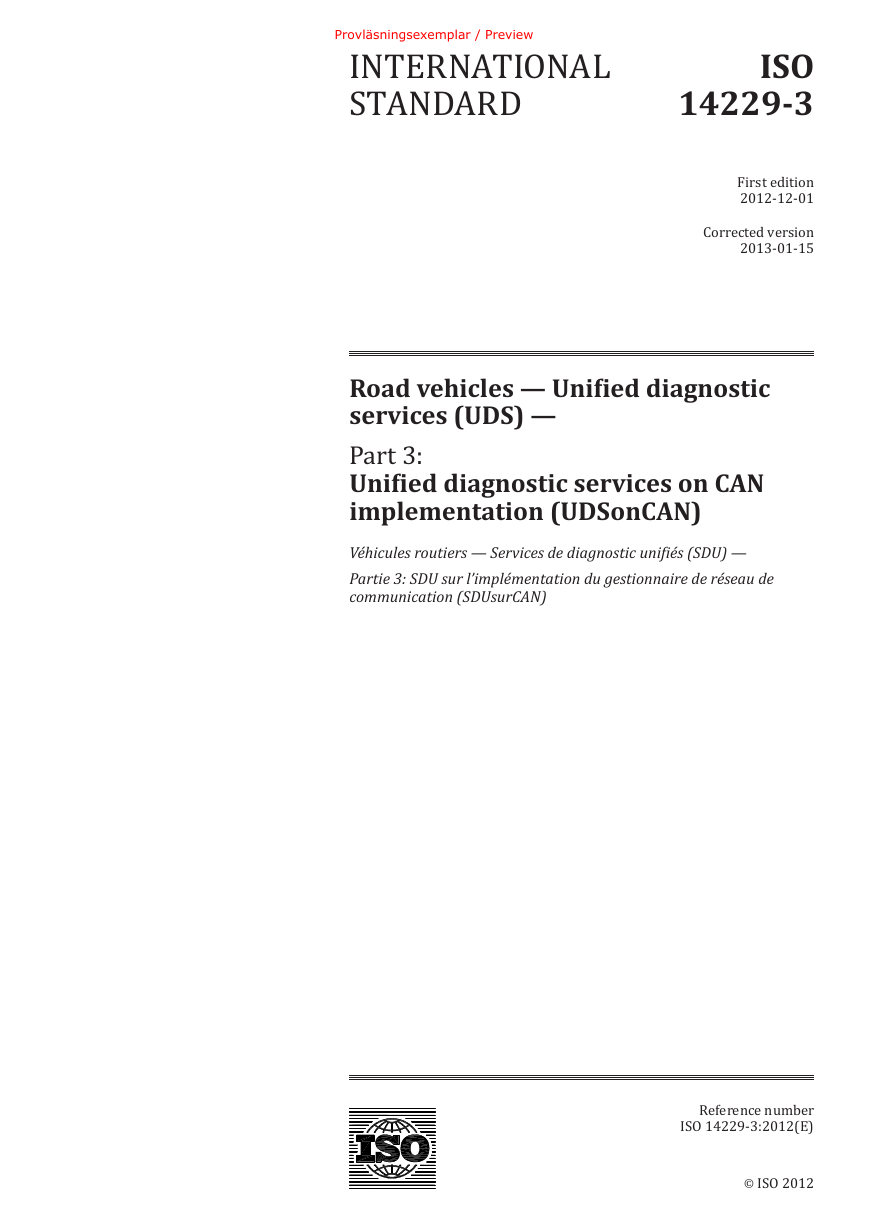

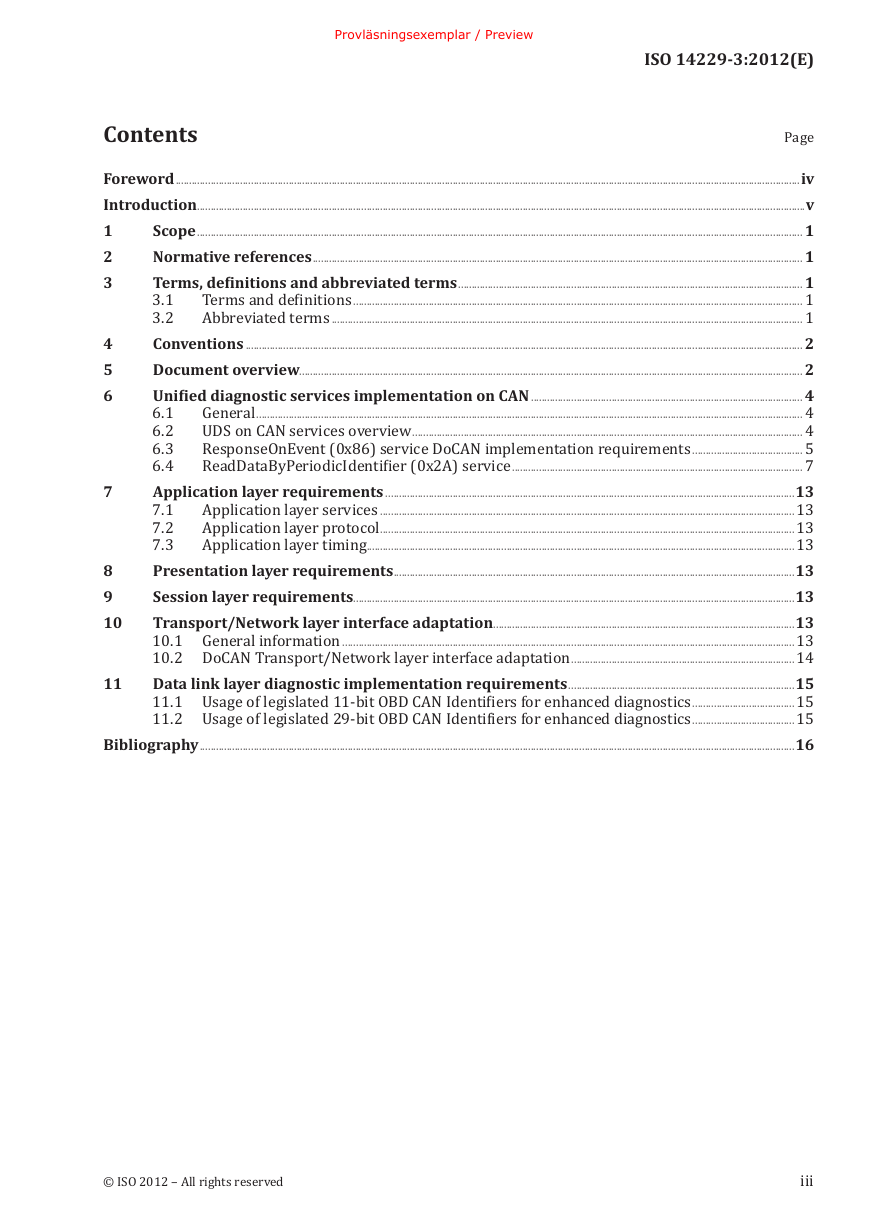
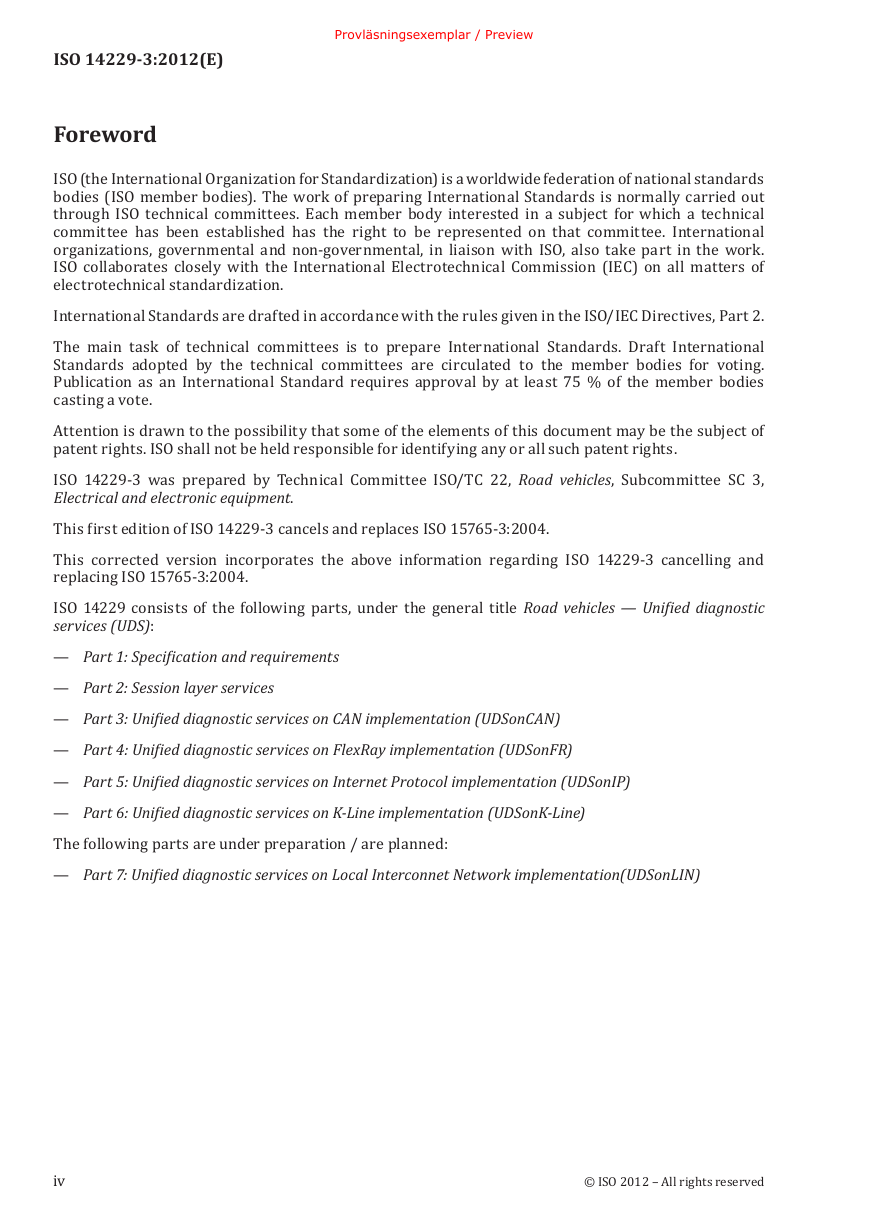
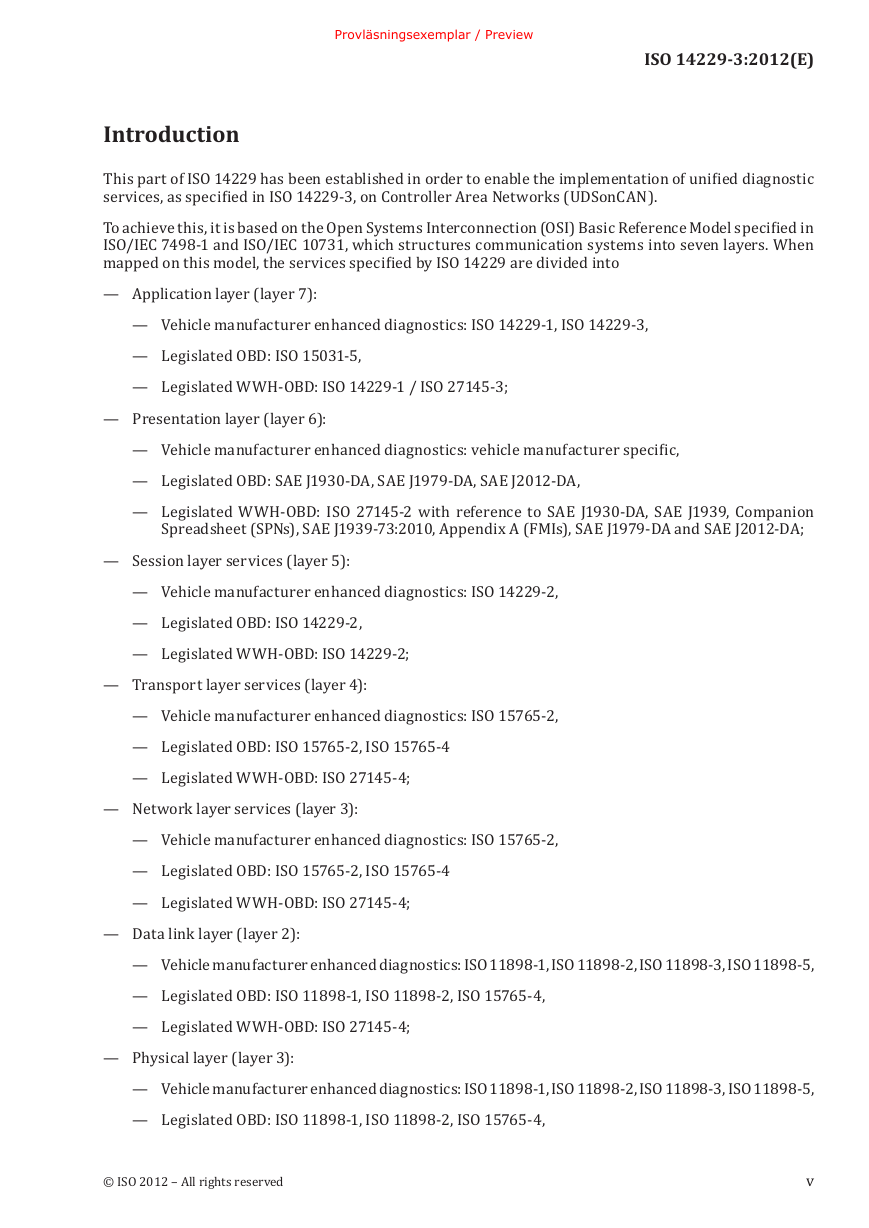
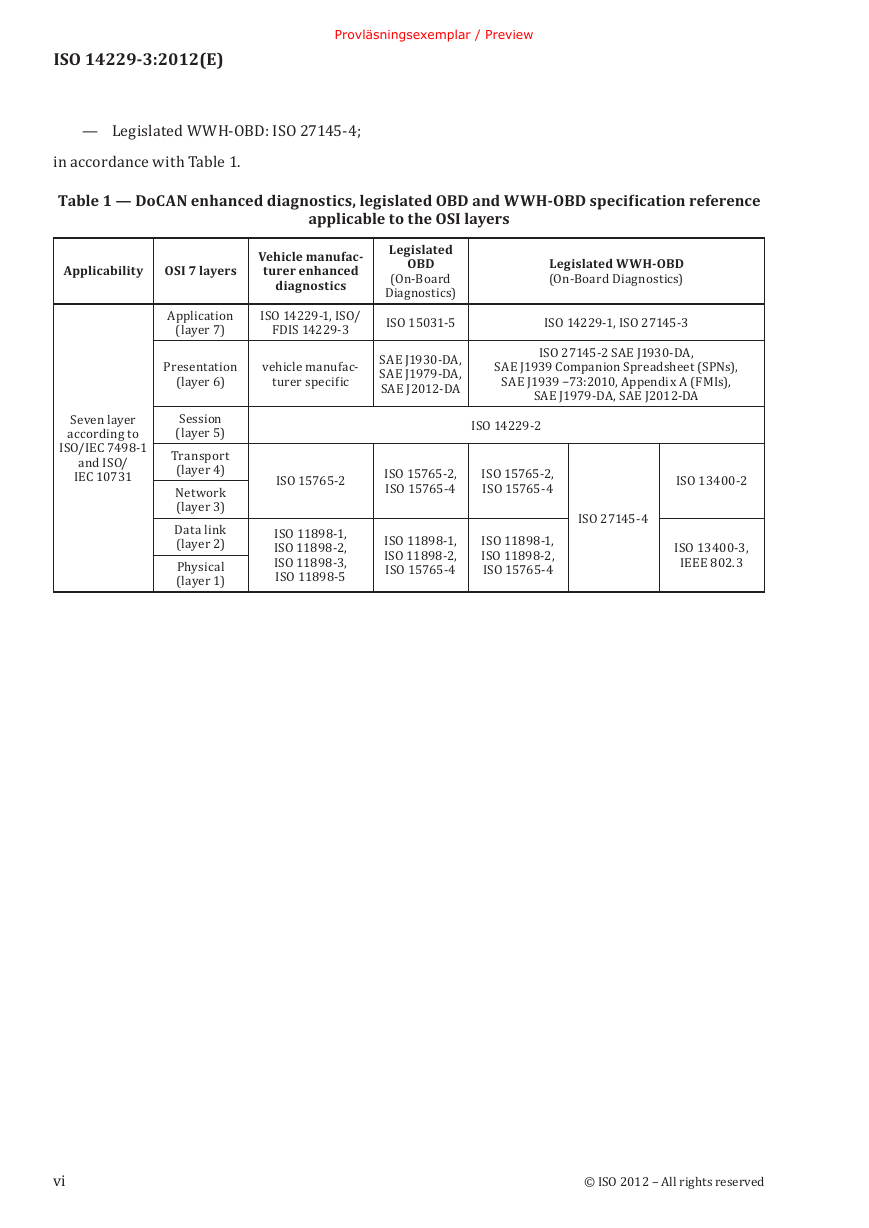
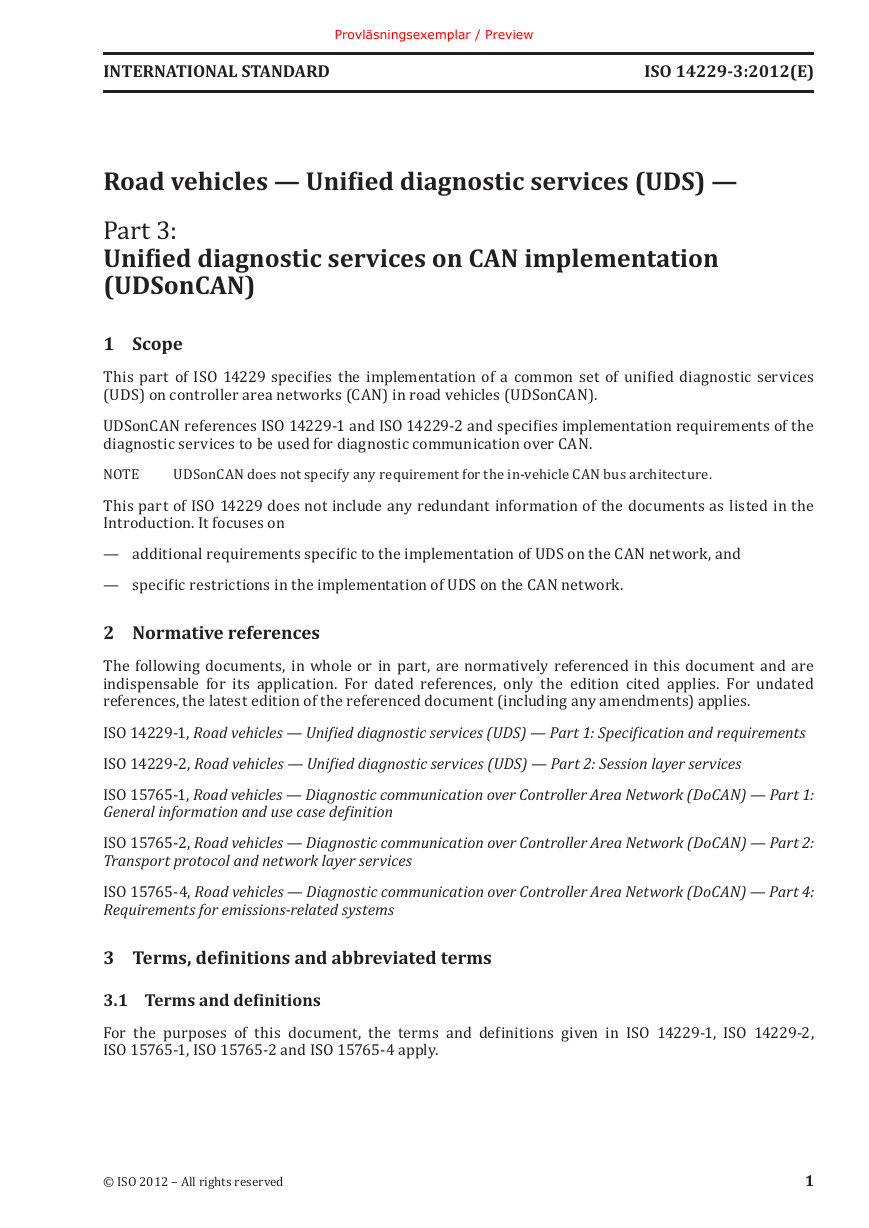









 2023年江西萍乡中考道德与法治真题及答案.doc
2023年江西萍乡中考道德与法治真题及答案.doc 2012年重庆南川中考生物真题及答案.doc
2012年重庆南川中考生物真题及答案.doc 2013年江西师范大学地理学综合及文艺理论基础考研真题.doc
2013年江西师范大学地理学综合及文艺理论基础考研真题.doc 2020年四川甘孜小升初语文真题及答案I卷.doc
2020年四川甘孜小升初语文真题及答案I卷.doc 2020年注册岩土工程师专业基础考试真题及答案.doc
2020年注册岩土工程师专业基础考试真题及答案.doc 2023-2024学年福建省厦门市九年级上学期数学月考试题及答案.doc
2023-2024学年福建省厦门市九年级上学期数学月考试题及答案.doc 2021-2022学年辽宁省沈阳市大东区九年级上学期语文期末试题及答案.doc
2021-2022学年辽宁省沈阳市大东区九年级上学期语文期末试题及答案.doc 2022-2023学年北京东城区初三第一学期物理期末试卷及答案.doc
2022-2023学年北京东城区初三第一学期物理期末试卷及答案.doc 2018上半年江西教师资格初中地理学科知识与教学能力真题及答案.doc
2018上半年江西教师资格初中地理学科知识与教学能力真题及答案.doc 2012年河北国家公务员申论考试真题及答案-省级.doc
2012年河北国家公务员申论考试真题及答案-省级.doc 2020-2021学年江苏省扬州市江都区邵樊片九年级上学期数学第一次质量检测试题及答案.doc
2020-2021学年江苏省扬州市江都区邵樊片九年级上学期数学第一次质量检测试题及答案.doc 2022下半年黑龙江教师资格证中学综合素质真题及答案.doc
2022下半年黑龙江教师资格证中学综合素质真题及答案.doc